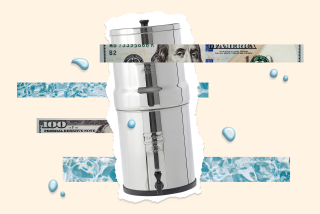Skies Finally Clearing for Pollution Control Firm
- Share via
Albert E. Gosselin Jr. keeps a statuette of a prize bull in his office that reminds the mechanical engineer never to invest in a business he doesn’t know anything about--a business, say, like cattle ranching.
Gosselin’s small Glendale company has been making devices that monitor air pollution for about 18 years, but Dasibi Environmental Corp. has annual sales of only $4.6 million, mainly thanks to the bum steers Gosselin got when advisers persuaded him in 1973 to merge his company with a supposedly cash-rich Colorado cattle ranch--a mistake that cost Dasibi time and money.
Now Gosselin, 56, said a $2.2-million infusion from a new stock offering completed in June will give him the chance to expand his business in a big way, something he has been waiting to do since 1973.
The plan is for the company to strike out for new markets--particularly South Korea--where Gosselin says relatively recent air cleanup efforts offer a great opportunity. “It’s a primitive enough area that we feel we are on an equal footing with everybody else,” Gosselin said.
Traditionally, 70% of Dasibi’s sales have been in the domestic market. But 70% of Dasibi’s sales for the last quarter were in the foreign market. The changeover started when Dasibi won a contract to monitor pollution in Seoul during the 1988 Olympic Games. To get that contract, Dasibi sold its monitors at cost. This year, Dasibi won a contract that Gosselin said was worth about $600,000 to provide monitors to the Korean equivalent of the U.S. Environmental Protection Agency. And now the company is chasing a $2.4-million contract to monitor emissions at a large steel plant in Pohang, South Korea.
Gosselin plans to set up marketing offices in Asia and Europe, and by doing so he hopes to nearly double the company’s sales this year to about $9 million.
Dasibi’s basic products are electronic devices that detect pollutants in the air and in smokestack gases. Most of them are about the size and shape of stereo receivers, and analyze gases optically, using ultraviolet light, for instance. The monitors cost between $4,000 and $25,000.
Dasibi sells the devices to government agencies that monitor general air quality and to factories seeking to assure that they comply with legal limits on emissions of sulfur dioxide and other pollutants.
Gosselin said Dasibi is also poised to profit from any increase in environmental enforcement in the United States, like that promised in the clean air bill working its way through Congress.
“Somebody is going to make a buck out of the clean air bill, that’s for sure,” said Dick Martin, an environmental services analyst for Louis Nicoud & Associates in New York. The $50-million annual U.S. market for smokestack-mounted pollution monitors will increase 25% a year for several years if a clean air bill passes, said Stephen Schweich of Alex. Brown & Sons in Baltimore.
But even if the U.S. pollution market grows, Dasibi faces some serious obstacles. For one thing, Dasibi is the smallest of a handful of companies in the pollution monitor market, facing competitors like Massachusetts-based Thermo Instruments, which has annual sales of $120 million and is a division of Thermo Electron, which has annual sales of $400 million, and a Colorado-based division of Lear Siegler that has annual sales of $2.5 billion. And KVB, based in Tustin, entered the business about six years ago after making pollution reduction devices.
Besides its competitors, Dasibi must also worry about its longtime dependence on one kind of pollution detector: ozone monitors, which last year accounted for nearly half of its sales.
Since 1982, Dasibi has invested research and development money in expanding its product line into detectors for other pollutants like sulfur dioxide and nitrogen oxides. As part of that plan, Dasibi agreed in August to buy two companies with key product lines for about $560,000. AIM of Pasadena makes a type of smokestack emissions monitor that analyzes smoke as it passes, instead of diverting samples for analysis. But the EPA hasn’t approved that monitor for use in the United States and Gosselin admits that could take a while.
The other company, EIS, makes a computer device that helps convert data from Dasibi monitors into a computer-usable form so the company can sell entire pollution-monitoring systems, instead of just detectors.
But the competition has had similar products for several years and Schweich said it would be tough for any challenger to strip away loyal customers from better-known companies.
A mechanical engineer by training, Gosselin got his start in pollution control in 1959 when he headed a Southern California Edison project that studied smokestack emissions from oil-burning power plants. After a few years with a New York air pollution control company, Gosselin moved back to California to start his own engineering company, which eventually went public in 1969.
It was Dasibi’s parent company, Pollution Research and Control Corp. (PRCC), that bought the troublesome cattle ranch in 1973 and planned to sell it for more than $1.5 million--cash he’d planned to use to expand the pollution control business.
As it turned out, the parts he could sell of the ranch were worth about $100,000, and the acquisition brought Gosselin only legal headaches and a six-year cash squeeze. The history of the ranch was muddied because it had been run by executives of Equity Funding, a Century City insurance company that went bankrupt in 1973 after it was discovered that it had been manipulating its books for years.
On that news, Dasibi’s banks seized hundreds of thousands of dollars in deposits to cover loans to the pollution control company. Suddenly Dasibi couldn’t meet major contract obligations. Sales fell from about $2 million in 1972 to about $100,000 in 1974.
“It was like a bad dream,” Gosselin said.
For five or six years, the company frequently operated with current liabilities greater than current assets and Dasibi couldn’t get a bank loan until 1980. “It took that long to get credibility back,” Gosselin said.
After a few years of revamping its product lines, Gosselin converted Dasibi’s parent into a mere holding company and took Dasibi public with a new stock offering. Eventually, PRCC gave all its holdings in the pollution control business to Dasibi’s shareholders and Gosselin sold off the former parent company as a corporate shell.
With those maneuvers done, Dasibi built up its sales about 70% from 1985 to 1989. Now with another spurt in the U.S. pollution control market and the big foreign markets as well, Gosselin talks of increasing sales to about $70 million in five years.
But while trying to plan for that success, Gosselin admits one thought troubles him: “If we’d stayed on the straight path I think we could have been a pretty big company today.”
DASIBI ENVIRONMENTAL AT A GLANCE
Dasibi Environmental is a Glendale-based company that makes monitors for detecting air pollution form smokestacks and in the surrounding air. Founded in 1971, the company had 60 employees.
More to Read
Inside the business of entertainment
The Wide Shot brings you news, analysis and insights on everything from streaming wars to production — and what it all means for the future.
You may occasionally receive promotional content from the Los Angeles Times.










